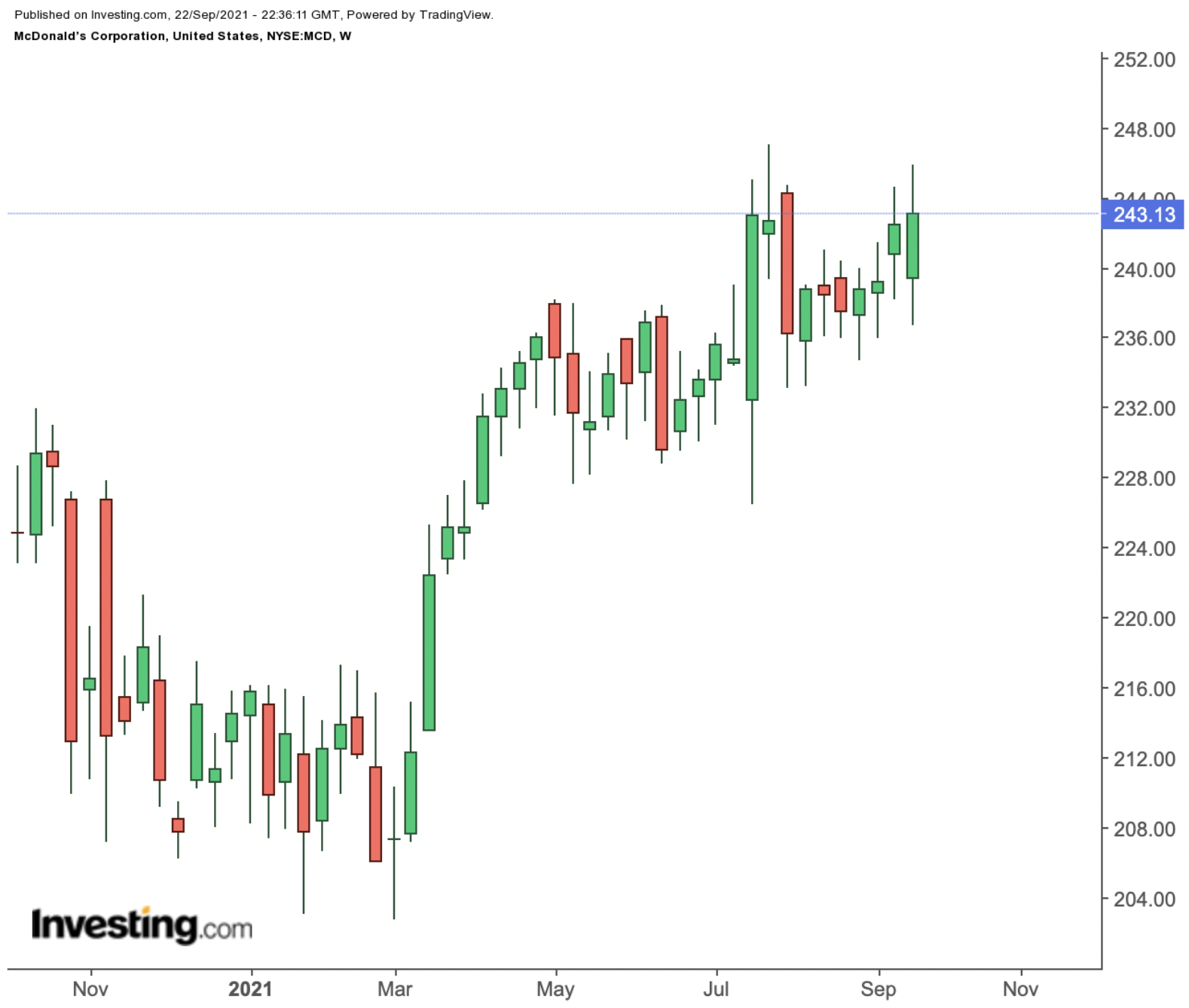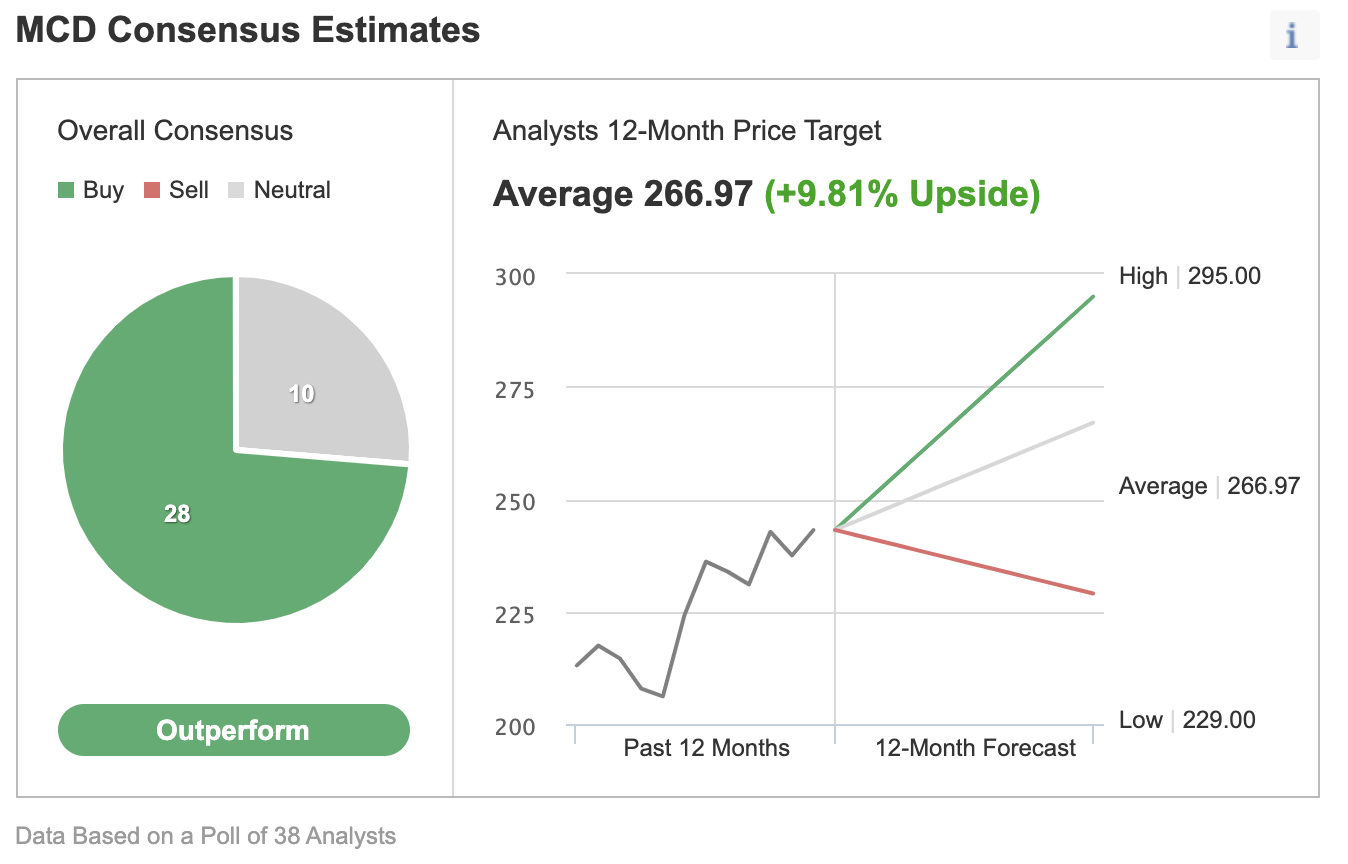- Dow-30 member McDonald’s is one of the most recognizable fast-food industry brands in the world
- MCD stock is up more than 12.5% so far in 2021, and saw a record high in July.
- Potential buy-and-hold investors could regard any short-term decline in McDonald’s shares as an opportune entry point
Investors in McDonald’s (NYSE:MCD) stock have had a solid 2021 as the shares are up close to 14.5% year-to-date. The stock hit an all-time high of $247.05 on July 27. On Sept. 22, MCD was at $245.15. This price supports a dividend yield of 2.1%.

The 52-week range for shares of the Chicago-based fast food chain and franchiser have ranged between $202.73 - $247.05, while the company’s market capitalization stands at $188.8 billion. McDonald’s is one of the 30 compenents of the mega cap Dow Jones index, which is up about 12.2% so far this year.
McDonald’s is the leading global food service retailer in the “Quick Service Restaurant (QSR)” segment. It operates more than 38,000 locations worldwide. The brand is also among the most valuable globally.
At the end of July, McDonald's issued robust Q2 results. Revenue of $5.89 billion was up 57% year-over-year. Net income and non-GAAP EPS were $2.22 billion and $2.37, respectively.
Investors were pleased to see U.S. same-store sales increased by 25.9% in the quarter and 14.9% on a two-year pre-pandemic basis. Global same-store sales were up 40.5% from a year ago and 6.9% on a two-year basis.
On the results, CEO Chris Kempczinski said:
“Our performance is continued demonstration of the broad-based strength and resiliency of our business as global comp sales in the second quarter increased nearly 7% over 2019… It is clear that our next chapter will be driven by our leadership in digital.”
More than 14,000 McDonald's outlets are based in the U.S. Next in line are Japan, China, Germany, Canada, France, the UK and Australia.
Although the pandemic is still a concern for management, McDonald’s believes several catalysts, such as delivery, digital ordering and self-serve kiosks, along with customer loyalty, will help drive revenue growth. The global brand recognition means customers trust the brand, leading to increased global sales and positive earnings.
What To Expect From MCD Stock
Among 38 analysts polled via Investing.com, McDonald's stock has an ‘outperform' rating. The shares have a 12-month price target of $266.97, implying a return of close to 9% from current levels. The 12-month price range currently stands between $229 and $295.

Chart: Investing.com
The trailing P/E, and P/S ratios for MCD stock stand at 26.19x and 8.26x respectively, indicating overstretched valuation levels by historical standards.
For comparison, ratios for Yum! Brands (NYSE:YUM), whose restaurant chains include KFC, Pizza Hut and Taco Bell, are 28.65x and 5.88x. Similarly these two ratios for The Wendy’s Co (NASDAQ:WEN) are 26.65x and 2.58x.
Investors who watch technical charts might be interested to know that a number of MCD stock short-term oscillators are overbought. Although they can stay extended for weeks, if not months, potential profit-taking could also be around the corner. When we look at longer-term technical indicators, we note that the bull run on McDonald's could potentially take the shares to new record highs in the months ahead.
Yet, if broader markets, or consumer shares, were to come under pressure during the rest of the month or during October, we could first see McDonald’s stock decline toward $235, or even $230, after which it could trade sideways while it establishes a new base. In the case of such a decline, MCD is likely to find strong support around the $230 level.
However, our expectation is for the stock to make a new leg higher, which will take it over the recent all-time high of $247.05, and then possibly toward $260. Although MCD shares be volatile in the short run, we are bullish on the Golden Arches.
3 Possible Trades
1. Buy MCD Stock At Current Levels
Investors who are not concerned with daily moves in price and who believe in the long-term potential of the company could consider investing in McDonald’s stock now.
On Sept. 22, MCD stock closed at $243.13. Buy-and-hold investors should expect to keep this long position for several months while the stock first makes another attempt at the record high of $247.05, and then toward $266.97, per analysts’ consensus estimate. Such a move would lead to a return of about 9%.
Meanwhile, investors who are concerned about large declines might also consider placing a stop-loss at about 3-5% below their entry point.
2. Buy An ETF With MCD As A Main Holding
Many readers are familiar with the fact that we regularly cover exchange-traded funds (ETFs) that might be suitable for buy-and-hold investors. Thus, readers who do not want to commit capital to McDonald’s stock but would still like to have substantial exposure to the shares could consider researching a fund that holds the company as a top holding.
Examples of such ETFs include:
- SPDR Dow Jones Industrial Average ETF Trust (NYSE:DIA): The fund is up 12.1% YTD, and MCD stock’s weighting is 5.72%;
- Invesco Dynamic Leisure and Entertainment ETF (NYSE:PEJ): This fund is up 24.9% YTD, and MCD stock’s weighting is 5.04%;
- iShares Evolved U.S. Consumer Staples ETF (NYSE:IECS): The fund is up 5.5% YTD, and MCD stock’s weighting is 4.56%.
3. Buy A LEAPS Option As A Surrogate For Owning MCD Stock
Investors who would like to buy 100 shares of McDonald’s stock would need to invest $24,313 (current price of $243.13 X 100 shares).
For many investors who are bullish on McDonald’s, this amount would be a sizeable investment. Although it is also possible to buy a few shares of a given stock (or even fractional shares), some investors could also be interested in buying a LEAPS call option.
For example, they could consider buying a LEAPS call with a delta of 0.80, such as the MCD Jan. 19, 2024, 145-strike call option. This option is currently offered at $101.25. In other words, investors would need to pay a premium of $10,125 to buy this LEAPS call option.
We covered the mechanics and the risk/return profile of LEAPS here. But in simple terms, the delta rating shows the amount an option’s price is expected to move based on a $1 change in the underlying security.
In this case, if MCD stock goes up $1 to $246.15 (based on the intraday price we are using), the current option price of $101.25 would, in theory, be expected to increase by 80 cents, based on a delta of 0.80.
The profit-loss profile of this trade will differ constantly as the price of the underlying McDonald’s option changes. However, on Jan. 19, 2024, it would break even at an underlying price of $246.25. To arrive at this number, one can add the current option premium of $101.25 to the strike price of $145.00, i.e., $246.25.
The maximum return on the upside would be uncapped, depending on where MCD stock trades on the day the investor closes the position.
Investors should remember that although the expiry is in January 2024, this long-term option still expires. As the expiration date approaches, an option loses value at an accelerating rate. If McDonald’s stock were to tank and close below $145 in January 2023, the maximum loss would be $10,125. Therefore, trade management will be important.
